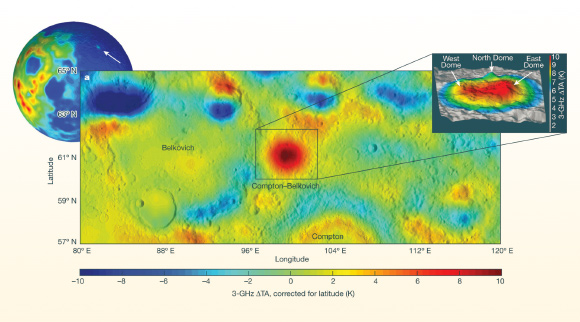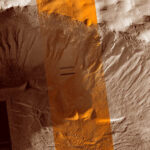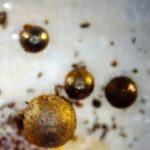The 50-km-diameter granitic system discovered below the far side feature known as Compton-Belkovich Volcanic Complex likely was formed from the cooling of molten lava that fed a volcano or volcanoes that erupted approximately 3.5 billion years ago.
This illustration shows the Compton-Belkovich Volcanic Complex (CBVC) on the Moon’s far side and the boxed area indicated a large granite zone, which could not be picked up by topography. Image credit: Siegler et al., doi: 10.1038/s41586-023-06183-5.
Granites, which result from magma due to igneous activity, are nearly absent in the Solar System outside of Earth.
Previously, only several grains of granite were detected in the hundreds of kilograms of rocks returned by NASA’s Apollo missions, and remote sensing studies since have found only a few small granite or granite-like features on the Moon.
Stony Brook University’s Professor Timothy Glotch and colleagues used remote sensing measurements, specifically orbital microwave radiometry and gravity measurements, to detect a large granitic body underneath the Compton-Belkovich Volcanic Complex (CBVC).
“Typically, granites require either plate tectonics or water-bearing magmas to form,” Professor Glotch said.
“While the lunar interior contains small amounts of water, the Moon has never undergone plate tectonics.”
“Therefore, this discovery of the granitic complex, or batholith underneath the CBVC, points to some not-yet-understood process that is responsible for the granitic formation.”
“Any big body of granite that we find on Earth used to feed a big bunch of volcanoes, much like a large system is feeding the Cascade volcanoes in the Pacific Northwest today,” said Dr. Matthew Siegler, a researcher at the Planetary Science Institute.
“Batholiths are much bigger than the volcanoes they feed on the surface. For example, the Sierra Nevada mountains are a batholith, left from a volcanic chain in the western United States that existed long ago.”
While the researchers are not yet sure what the process is, there could a number of possibilities.
These could include a fractionation of KREEP (potassium-rare-earth-elements-and-phosphorus) basaltic liquids, or partial melting KREE-rich crust.
If either of these were the case, it would require an abnormally hydrous mantle underneath the CBVC and a compositionally heterogenous lunar mantle.
“The surprising magnitude and geographic extent of this feature imply and Earth-like, evolved granite system larger than believed possible on the Moon, especially outside of the Procellarum region — a phenomenon previously documented only on Earth,” the scientists said.
“In addition to the discovery, the remote sensing method that this work illustrates a new tool for mapping planetary geothermal gradient from orbit through passive microwave radiometry, which can provide a window into crustal and interior heat-producing structures.”
“Furthermore, the methods used are generalizable, and similar uses of passive radiometric data could vastly expand our knowledge of geothermal processes on the Moon and other planetary bodies.”
The findings appear today in the journal Nature.
_____
M.A. Siegler et al. Remote detection of a lunar granitic batholith at Compton-Belkovich. Nature, published online July 5, 2023; doi: 10.1038/s41586-023-06183-5




